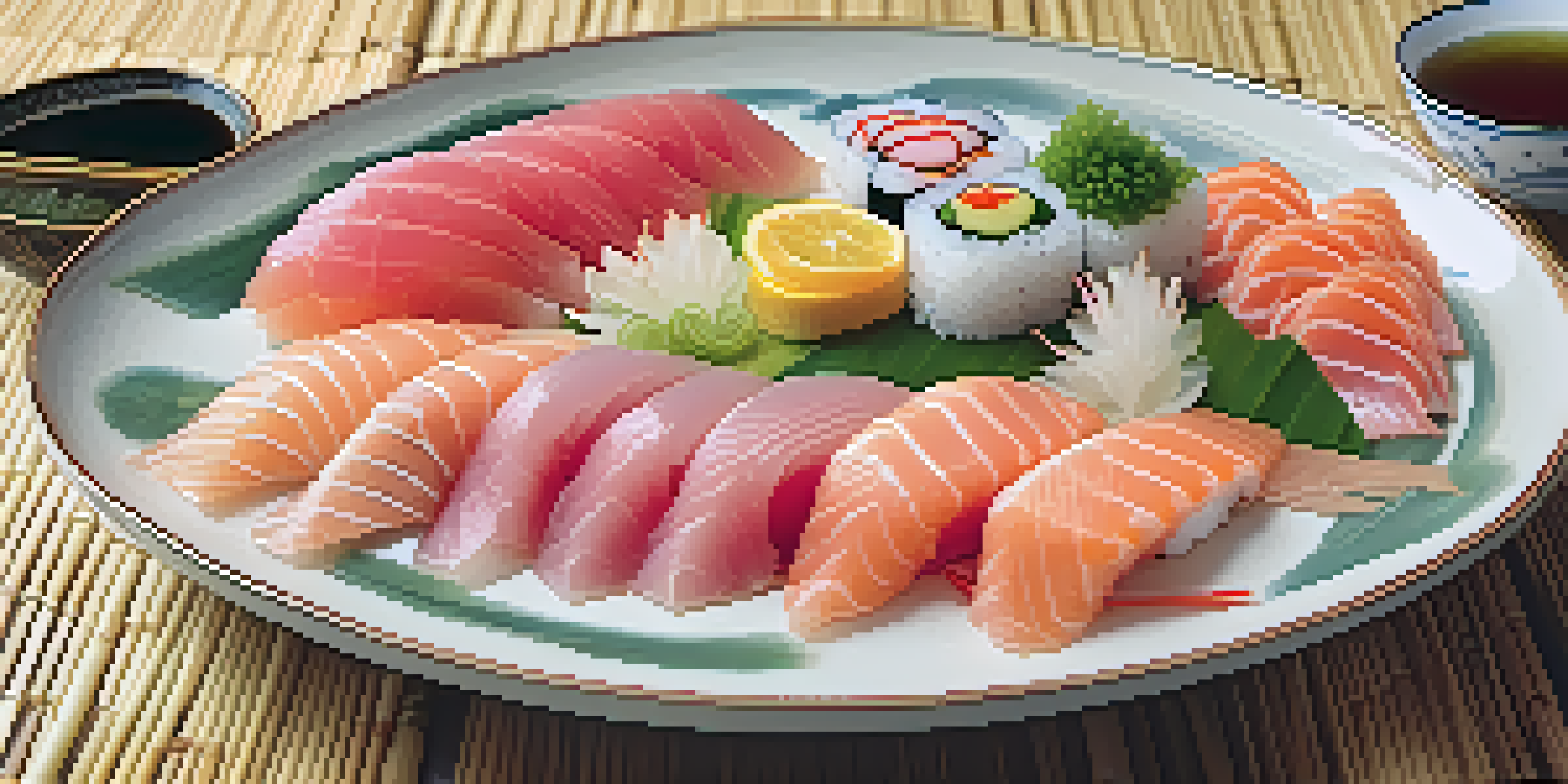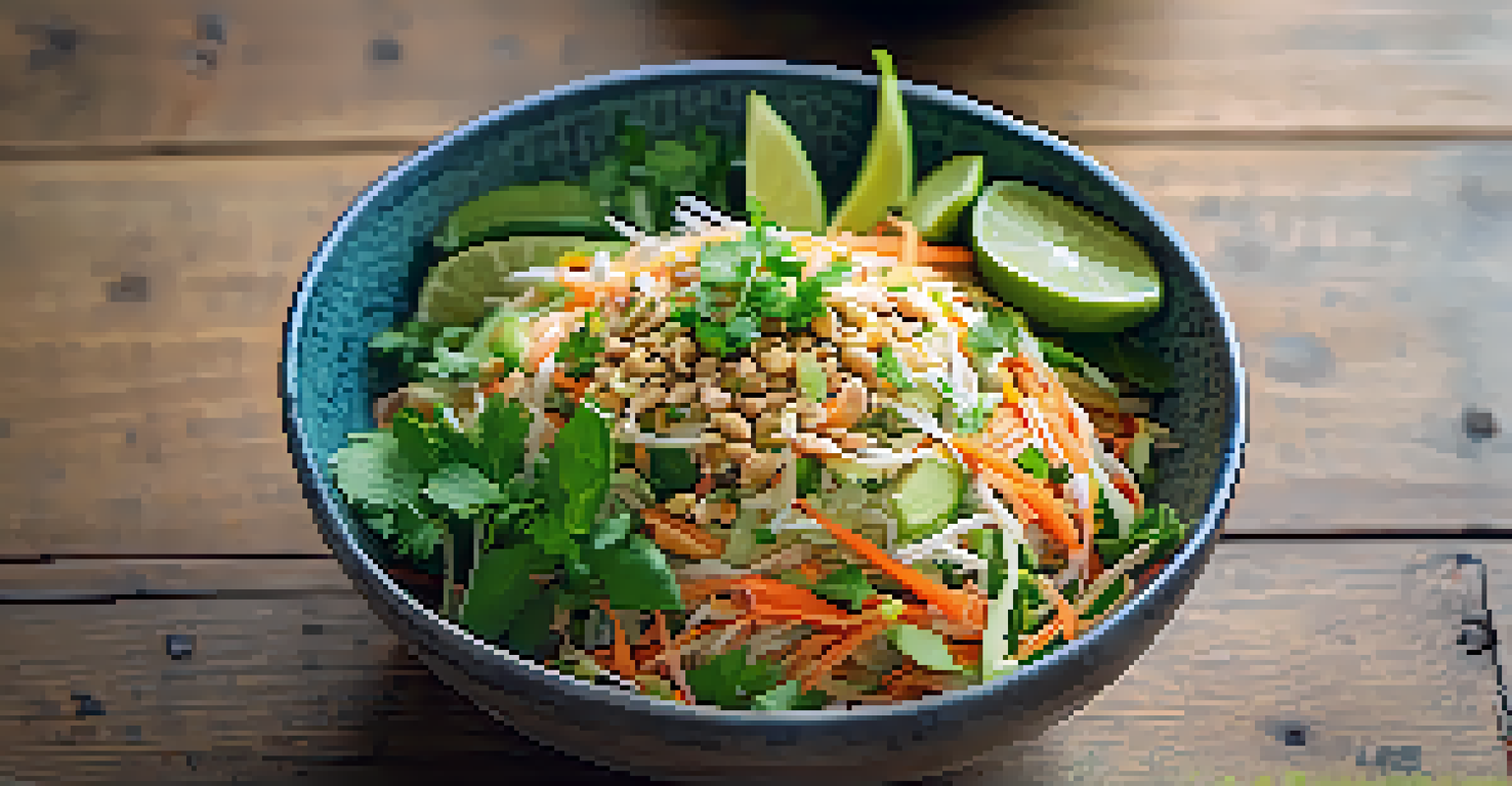The Role of Raw Food in Traditional Asian Cuisines Explained

Understanding Raw Food in Asian Cultures
Raw food has been a staple in many traditional Asian cuisines, embodying health, freshness, and simplicity. Cultures like Japanese, Chinese, and Thai often emphasize the use of fresh ingredients, showcasing them in their most natural state. This approach not only preserves essential nutrients but also connects people to the flavors of their local environment.
Let food be thy medicine and medicine be thy food.
In Japan, for instance, dishes such as sashimi highlight the quality of raw fish, celebrating its delicate taste and texture. Similarly, in Chinese cuisine, dishes like cold noodles or fresh spring rolls allow ingredients to shine without heavy sauces. This practice of consuming raw food is rooted in cultural beliefs about health and vitality, making it a cherished aspect of culinary traditions.
Raw food also plays a role in seasonal eating, where ingredients are selected based on their freshness and availability. This not only enhances flavor but also promotes sustainability, as it encourages the use of local produce. Overall, raw food serves as a bridge between nature and the plate, emphasizing the importance of quality ingredients in Asian culinary practices.
The Nutritional Benefits of Raw Ingredients
Eating raw food is often associated with numerous health benefits, particularly due to the preservation of vitamins and minerals. Cooking can sometimes diminish the nutritional content of ingredients, while raw food maintains their integrity. This is particularly true for fruits and vegetables, which are often packed with antioxidants that support overall well-being.

For example, in Thai cuisine, fresh herbs like cilantro and mint not only add flavor but are also rich in vitamins A and C. Consuming these herbs raw maximizes their health benefits, contributing to a balanced diet. Additionally, raw foods are typically lower in calories and can aid in weight management, making them a popular choice for health-conscious individuals.
Cultural Importance of Raw Food
Raw food is deeply intertwined with traditions and rituals in many Asian cultures, highlighting its role in community and identity.
Moreover, the natural enzymes found in raw foods can improve digestion and nutrient absorption. Many Asian cultures recognize this, incorporating raw ingredients into meals to enhance digestive health. By prioritizing raw food, traditional Asian cuisines promote a holistic approach to nutrition that aligns with their cultural values.
Raw Food Preparation Techniques in Asia
The art of preparing raw food varies across Asian cuisines, showcasing a rich tapestry of techniques and traditions. In Japan, for instance, the practice of sushi-making highlights skillful knife techniques to ensure fish is cut perfectly for sashimi. This precision not only affects taste but also presentation, emphasizing the aesthetic value of raw ingredients.
You are what you eat, so don't be fast, cheap, easy, or fake.
Similarly, in Korean cuisine, dishes like kimchi involve fermenting vegetables, which is a unique way to enhance flavors while still retaining a raw essence. The fermentation process introduces beneficial probiotics, making it a healthful addition to meals. This technique reflects a deep respect for raw ingredients and their transformative potential.
In contrast, Thai cuisine often uses a method called 'som tam,' where fresh vegetables are pounded together to create a salad. This technique not only combines flavors but also enhances the texture of raw ingredients, making them more enjoyable to eat. These diverse preparation methods reflect the creativity and respect for raw food that characterize traditional Asian cooking.
Cultural Significance of Raw Food
Raw food holds cultural significance in many Asian societies, often intertwined with traditions, celebrations, and rituals. For instance, in Japan, the practice of eating fresh seafood is not only a culinary choice but also a cultural ritual, with sushi often served during important occasions. This connection between food and culture emphasizes the role of raw ingredients in creating community and fostering relationships.
In China, the tradition of serving fresh fruits during festivals symbolizes prosperity and good fortune. This practice highlights the importance of raw food as a means of expressing hope and positivity within familial and communal settings. It is a reminder that food is more than sustenance; it is a way to connect with one another.
Health Benefits of Raw Ingredients
Consuming raw foods preserves essential nutrients and promotes digestive health, making them a popular choice for health-conscious individuals.
Furthermore, many Asian cultures view raw foods as a way to honor nature and its cycles. By consuming ingredients in their raw state, individuals show respect for the environment and the resources it provides. This cultural reverence for raw food reinforces its role as a fundamental aspect of identity and heritage in Asian cuisines.
Popular Raw Dishes Across Asia
Across Asia, numerous dishes celebrate the beauty and flavor of raw ingredients, each reflecting the unique culinary heritage of its region. In Japan, dishes like sashimi and sunomono (vinegared salads) exemplify the country's dedication to freshness and simplicity. These dishes showcase the natural flavors of seafood and vegetables, allowing diners to appreciate their quality.
Moving to Thailand, dishes such as som tam (green papaya salad) and larb (a meat salad) highlight the vibrant use of raw ingredients. Som tam combines fresh vegetables with a zesty dressing, while larb features raw minced meat mixed with herbs and spices, creating a refreshing yet bold flavor profile. These dishes are not only delicious but also exemplify the balance of flavors that Thai cuisine is known for.
In Korea, bibimbap often includes an array of raw vegetables served atop rice, allowing diners to mix and match flavors to their preference. This interactive dining experience not only emphasizes the importance of fresh ingredients but also encourages communal enjoyment of food. Each of these dishes illustrates how raw food plays a vital role in Asian culinary traditions.
The Influence of Modern Trends on Raw Food
In recent years, the global trend towards health-conscious eating has sparked a renewed interest in raw food within Asian cuisines. As people become more aware of nutrition and sustainability, traditional practices are being revisited and adapted to fit modern lifestyles. This movement celebrates the return to whole, unprocessed ingredients that align with traditional values.
For example, many Asian restaurants now offer raw food options, catering to health-conscious consumers. Dishes that were once traditional are being reimagined to highlight the benefits of raw ingredients, such as raw fish tacos or sushi burritos. This fusion of old and new demonstrates the versatility of raw food and its ability to evolve with changing palates.
Sustainability in Raw Food Practices
Emphasizing local and seasonal ingredients, traditional Asian cuisines align with sustainable eating practices that support the environment.
Moreover, social media platforms have played a significant role in popularizing raw food trends, with visually appealing dishes gaining traction among food enthusiasts. This exposure encourages individuals to experiment with raw ingredients, inspiring a new generation to embrace traditional Asian cuisines. As a result, raw food continues to thrive as a vital component of culinary innovation.
Sustainability and Raw Food Practices
Sustainability is a growing concern in today's world, and raw food practices in traditional Asian cuisines align well with this movement. By focusing on fresh, local ingredients, many of these cuisines promote a sustainable approach to eating. This not only supports local farmers but also reduces the carbon footprint associated with transporting food over long distances.
In countries like Japan, the farm-to-table philosophy is prevalent, where chefs prioritize sourcing ingredients from local markets. This practice ensures that the ingredients are not only fresh but also seasonal, minimizing waste and maximizing flavor. Such an approach reflects a deep-rooted respect for nature and the environment.

Additionally, traditional preservation methods, such as fermenting and pickling, help reduce food waste while enhancing the longevity of raw ingredients. These practices are not only practical but also cultural, emphasizing the importance of resourcefulness in Asian cuisines. Ultimately, embracing raw food contributes to a more sustainable way of eating, benefiting both individuals and the planet.